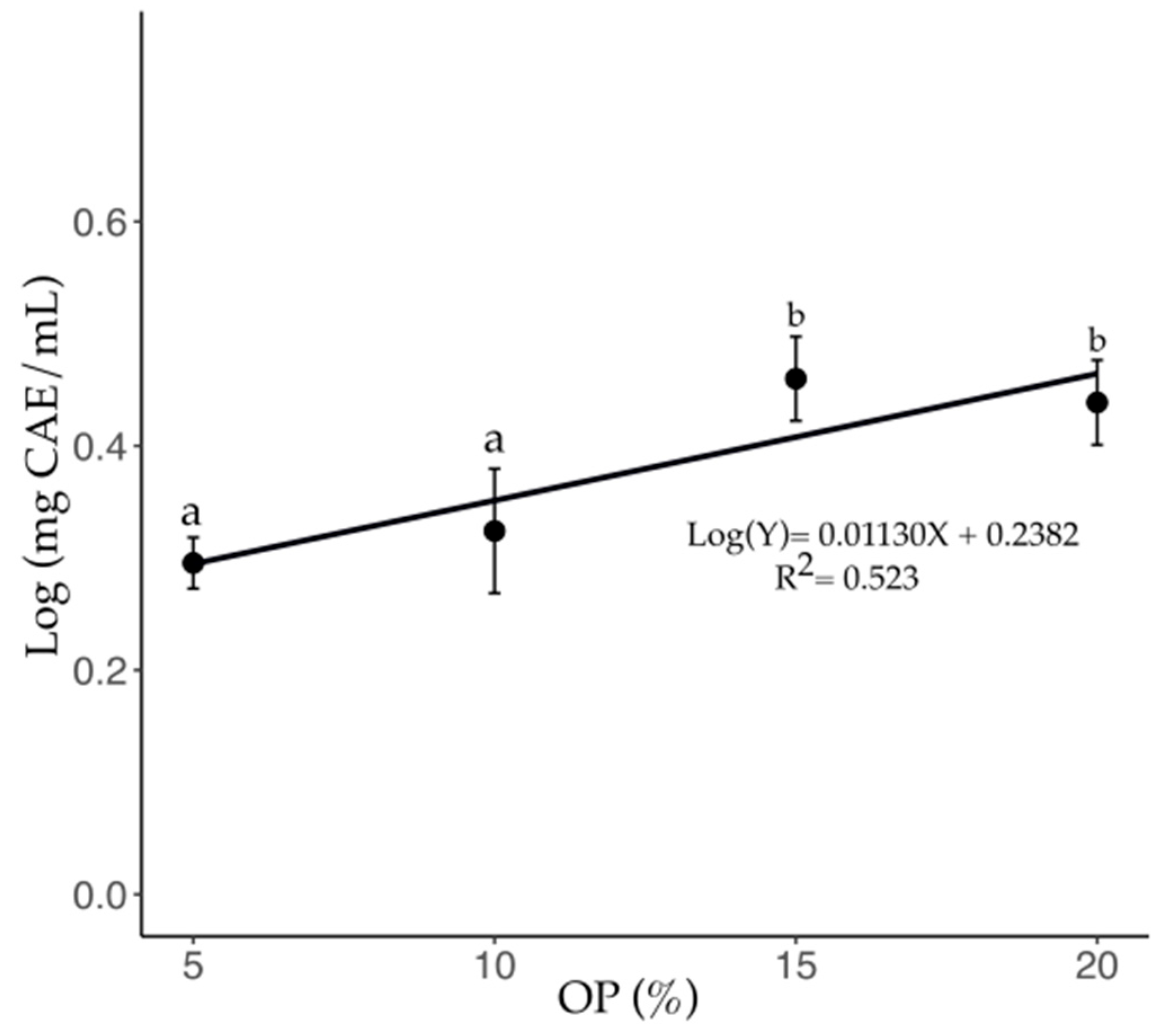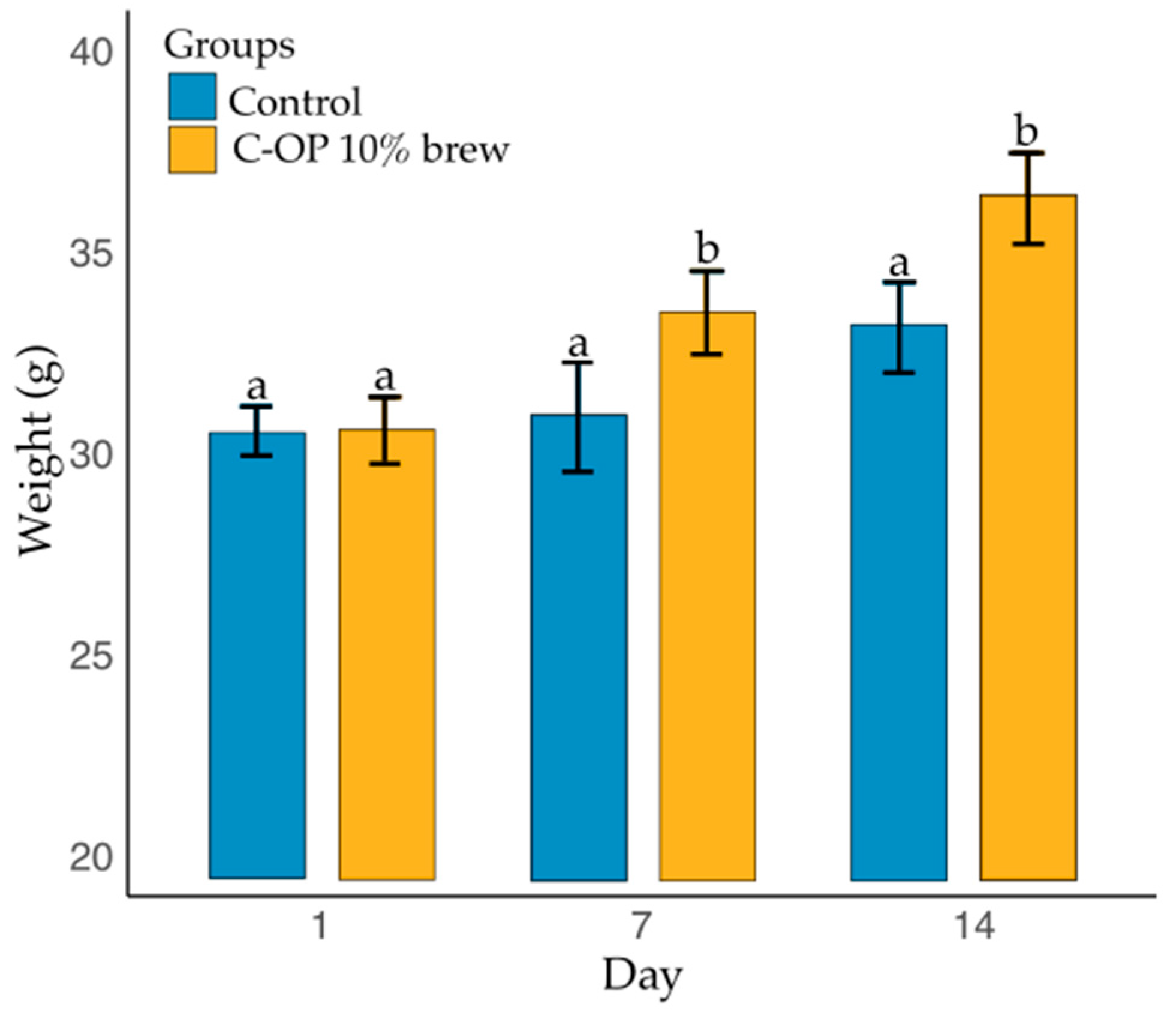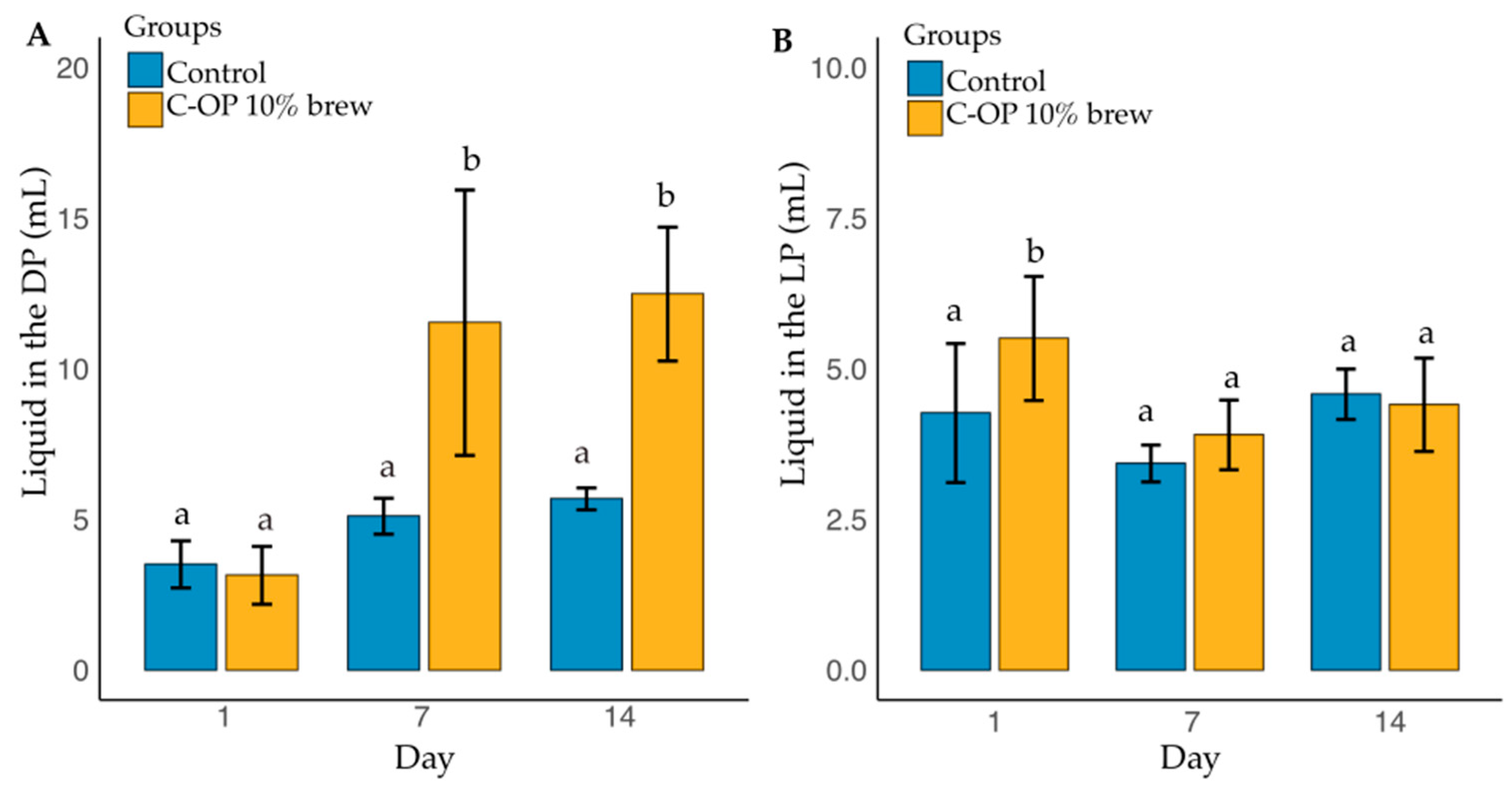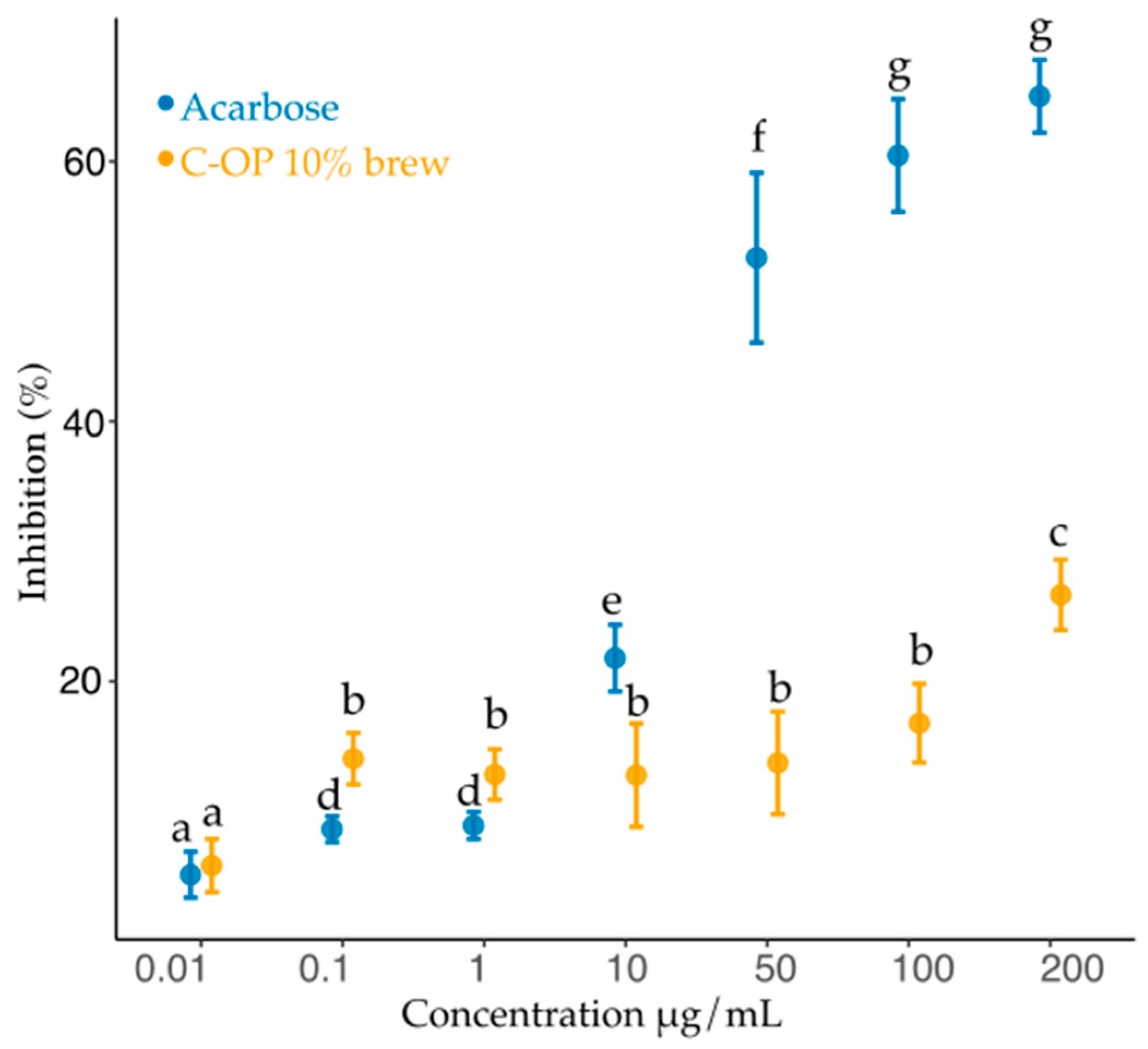A Functional Beverage from Coffee and Olive Pomace: Polyphenol-Flavonoid Content, Antioxidant, Antihyperglycemic Properties, and Mouse Behavior
Abstract
1. Introduction
2. Materials and Methods
2.1. Extraction and Drying of OP
2.2. Determination of C-OP Blend Brew Concentrations
2.3. Extraction of C-OP Brewing
2.4. Determination of Soluble Solids
2.5. Determination of Total Soluble Phenols
2.6. Determination of Total Flavonoids
2.7. Determination of Antioxidant Activity
2.8. Mouse Behavior Affected by C-OP Consumption
2.9. Inhibitory Activity Against α-Amylase
2.10. Statistical Analysis
3. Results
3.1. Soluble Solids, Phenolics, Flavonoid Content, and Antioxidant Activity of Coffee, OP Brew, and C-OP Brews
3.2. Mouse Behavior Affected by C-OP Consumption
3.2.1. Food Consumption
3.2.2. Weight Gain
3.2.3. Liquid Consumption
3.2.4. Mouse Behavior
3.3. Inhibitory Activity Against α-Amylase
4. Discussion
4.1. Composition of C-OP Brews
4.2. Content of Soluble Solids of C-OP Brews
4.3. Content of Total Soluble Phenols of C-OP Brews
4.4. Content of Total Healthy Flavonoids in C-OP Brews
4.5. Antioxidant Activity of C-OP Brews
4.6. Sensory Evaluation of the C-OP 10% Brew
4.6.1. Food Consumption in Murine Model of C-OP 10% Brew
4.6.2. Body Weight Gain in Murine Model of C-OP 10% Brew
4.6.3. Liquid Consumption in Murine Model of C-OP 10% Brew
4.6.4. Observed Behavior of Mice with and Without C-OP 10%
4.7. Inhibitory Activity Against α-Amylase of C-OP 10%
5. Conclusions
Author Contributions
Funding
Institutional Review Board Statement
Data Availability Statement
Acknowledgments
Conflicts of Interest
Abbreviations
| OP | Olive pomace |
| C-OP | Coffee and olive pomace |
| DPPH• | 2,2-diphenyl-1-picrylhydrazyl |
| CAE | Chlorogenic acid equivalents |
| CE | (+)-catechin equivalents |
| AP | Active phase |
| IP | Inactive phase |
| T2DM | Type 2 diabetes mellitus |
| TE | Trolox equivalent |
| DNS | Dinitrosalicylic acid |
References
- Barrea, L.; Pugliese, G.; Frias-Toral, E.; El Ghoch, M.; Castellucci, B.; Chapela, S.P.; Carignano, M.d.L.A.; Laudisio, D.; Savastano, S.; Colao, A.; et al. Coffee consumption, health benefits and side effects: A narrative review and update for dietitians and nutritionists. Crit. Rev. Food Sci. Nutr. 2023, 63, 1238–1261. [Google Scholar] [CrossRef]
- Makiso, M.U.; Tola, Y.B.; Ogah, O.; Endale, F.L. Bioactive compounds in coffee and their role in lowering the risk of major public health consequences: A review. Food Sci. Nutr. 2024, 12, 734–764. [Google Scholar] [CrossRef] [PubMed]
- Inzunza-Soto, M.; Thai, S.; Sinrod, A.J.G.; Olson, D.A.; Avena-Bustillos, R.J.; Li, X.; Rolston, M.R.; Wang, S.C.; Teran-Cabanillas, E.; Yokoyama, W.; et al. Health benefits of first and second extraction drum-dried pitted olive pomace. J. Food Sci. 2021, 86, 4865–4876. [Google Scholar] [CrossRef] [PubMed]
- Sutra, T.; Oiry, C.; Azay-Milhau, J.; Youl, E.; Magous, R.; Teissèdre, P.-L.; Cristol, J.-P.; Cros, G. Preventive Effects of Nutritional Doses of Polyphenolic Molecules on Cardiac Fibrosis Associated with Metabolic Syndrome: Involvement of Osteopontin and Oxidative Stress. J. Agric. Food Chem. 2008, 56, 11683–11687. [Google Scholar] [CrossRef] [PubMed]
- Carnevale, R.; Silvestri, R.; Loffredo, L.; Novo, M.; Cammisotto, V.; Castellani, V.; Bartimoccia, S.; Nocella, C.; Violi, F. Oleuropein, a component of extra virgin olive oil, lowers postprandial glycaemia in healthy subjects. Br. J. Clin. Pharmacol. 2018, 84, 1566–1574. [Google Scholar] [CrossRef]
- Sanlier, N.; Atik, A.; Atik, I. Consumption of green coffee and the risk of chronic diseases. Crit. Rev. Food Sci. Nutr. 2019, 59, 2573–2585. [Google Scholar] [CrossRef]
- Tangney, C.C.; Rasmussen, H.E. Polyphenols, Inflammation, and Cardiovascular Disease. Curr. Atheroscler. Rep. 2013, 15, 324. [Google Scholar] [CrossRef]
- Mirzaei, F.; Agbaria, L.; Bhatnagar, K.; Sirimanne, N.; A’Amar, N.O.; Jindal, V.; Thilagendra, A.G.; Raba, F.T. Coffee and Alzheimer’s disease. Prog. Brain Res. 2024, 289, 21–55. [Google Scholar] [CrossRef]
- Stefanello, N.; Spanevello, R.M.; Passamonti, S.; Porciúncula, L.; Bonan, C.D.; Olabiyi, A.A.; da Rocha, J.B.T.; Assmann, C.E.; Morsch, V.M.; Schetinger, M.R.C. Coffee, caffeine, chlorogenic acid, and the purinergic system. Food Chem. Toxicol. 2019, 123, 298–313. [Google Scholar] [CrossRef]
- Ungvari, Z.; Kunutsor, S.K. Coffee consumption and cardiometabolic health: A comprehensive review of the evidence. GeroScience 2024, 46, 6473–6510. [Google Scholar] [CrossRef]
- Ramli, N.N.S.; Alkhaldy, A.A.; Mhd Jalil, A.M. Effects of Caffeinated and Decaffeinated Coffee Consumption on Metabolic Syndrome Parameters: A Systematic Review and Meta-Analysis of Data from Randomised Controlled Trials. Medicina 2021, 57, 957. [Google Scholar] [CrossRef] [PubMed]
- Chung, H.-K.; Nam, J.S.; Lee, M.-Y.; Kim, Y.-B.; Won, Y.-S.; Song, W.-J.; Kim, Y.-H.; Ahn, C.W.; Sung, K.-C. The increased amount of coffee consumption lowers the incidence of fatty liver disease in Korean men. Nutr. Metab. Cardiovasc. Dis. 2020, 30, 1653–1661. [Google Scholar] [CrossRef] [PubMed]
- Nordestgaard, A.T.; Thomsen, M.; Nordestgaard, B.G. Coffee intake and risk of obesity, metabolic syndrome and type 2 diabetes: A Mendelian randomization study. Leuk. Res. 2015, 44, 551–565. [Google Scholar] [CrossRef] [PubMed]
- Carlström, M.; Larsson, S.C. Coffee consumption and reduced risk of developing type 2 diabetes: A systematic review with meta-analysis. Nutr. Rev. 2018, 76, 395–417. [Google Scholar] [CrossRef]
- Czachor, J.; Miłek, M.; Galiniak, S.; Stępień, K.; Dżugan, M.; Mołoń, M. Coffee Extends Yeast Chronological Lifespan through Antioxidant Properties. Int. J. Mol. Sci. 2020, 21, 9510. [Google Scholar] [CrossRef]
- Lucarini, M.; Durazzo, A.; Bernini, R.; Campo, M.; Vita, C.; Souto, E.B.; Lombardi-Boccia, G.; Ramadan, M.F.; Santini, A.; Romani, A. Fruit Wastes as a Valuable Source of Value-Added Compounds: A Collaborative Perspective. Molecules 2021, 26, 6338. [Google Scholar] [CrossRef]
- Pantuso, T. Prevention of diabetes with mediterranean diet. Integr. Med. Alert 2014, 17, 43–46. [Google Scholar] [CrossRef]
- Huo, R.; Du, T.; Xu, Y.; Xu, W.; Chen, X.; Sun, K.; Yu, X. Effects of Mediterranean-style diet on glycemic control, weight loss and cardiovascular risk factors among type 2 diabetes individuals: A meta-analysis. Eur. J. Clin. Nutr. 2015, 69, 1200–1208. [Google Scholar] [CrossRef]
- Martínez-González, M.A.; Sayón-Orea, C.; Bullón-Vela, V.; Bes-Rastrollo, M.; Rodríguez-Artalejo, F.; Yusta-Boyo, M.J.; García-Solano, M. Effect of olive oil consumption on cardiovascular disease, cancer, type 2 diabetes, and all-cause mortality: A systematic review and meta-analysis. Clin. Nutr. 2022, 41, 2659–2682. [Google Scholar] [CrossRef]
- Velotti, F.; Bernini, R. Hydroxytyrosol Interference with Inflammaging via Modulation of Inflammation and Autophagy. Nutrients 2023, 15, 1774. [Google Scholar] [CrossRef]
- Ferreira, D.M.; Oliveira, M.B.P.P.; Alves, R.C. A Comprehensive Review of the Antitumor Activity of Olive Compounds: The Case of Olive Oil, Pomace, and Leaf Extracts, Phenolic Alcohols, Secoiridoids, and Triterpenes. Antioxidants 2025, 14, 237. [Google Scholar] [CrossRef]
- Pędziwiatr, D.; Lamadrid, M.C.; Wojdyło, A. Cookies Fortified with Polyphenols Extracts: Impact on Phenolic Content, Antioxidant Activity, Inhibition of α-Amylase and α-Glucosidase Enzyme, Colour and Sensory Attractiveness. Antioxidants 2024, 13, 1108. [Google Scholar] [CrossRef] [PubMed]
- López-Huertas, E.; Rubí-Villegas, J.; Sánchez-Moreno, L.; Nieto, R. Olive Pomace Extract Contains Low Molecular Weight Peptides and Possesses ACE Inhibitory Activity. Int. J. Mol. Sci. 2024, 25, 3962. [Google Scholar] [CrossRef] [PubMed]
- Crespo, M.C.; Tomé-Carneiro, J.; Pintado, C.; Dávalos, A.; Visioli, F.; Burgos-Ramos, E. Hydroxytyrosol restores proper insulin signaling in an astrocytic model of Alzheimer’s disease. BioFactors 2017, 43, 540–548. [Google Scholar] [CrossRef] [PubMed]
- Pinotti, L.; Luciano, A.; Ottoboni, M.; Manoni, M.; Ferrari, L.; Marchis, D.; Tretola, M. Recycling food leftovers in feed as opportunity to increase the sustainability of livestock production. J. Clean. Prod. 2021, 294, 126290. [Google Scholar] [CrossRef]
- Loarca-Piña, G.; Neri, M.; Figueroa, J.d.D.; Castaño-Tostado, E.; Ramos-Gómez, M.; Reynoso, R.; Mendoza, S. Chemical characterization, antioxidant and antimutagenic evaluations of pigmented corn. J. Food Sci. Technol. 2019, 56, 3177–3184. [Google Scholar] [CrossRef]
- Brand-Williams, W.; Cuvelier, M.E.; Berset, C. Use of a free radical method to evaluate antioxidant activity. LWT Food Sci. Technol. 1995, 28, 25–30. [Google Scholar] [CrossRef]
- Secretaría de Agricultura, Ganadería, Desarrollo Rural, Pesca y Alimentación (SAGARPA). NOM-062-ZOO-1999; Especificaciones Técnicas para la Producción, Cuidado y uso de los Animales de Laboratorio. Diario Oficial de la Federación: Ciudad de México, México, 1999.
- Pereira-Alves, E.; Machado-Pereira, J.; Monteiro, A.; Costa-Cordeiro, R.; Chandran, V.; Jurisica, I.; Prado, E.; Cameron, L.C. Caffeine Boosts Weight-Lifting Performance in Rats: A Pilot Study. Nutrients 2024, 16, 2022. [Google Scholar] [CrossRef]
- Kelley, A.E. Measurement of Rodent Stereotyped Behavior. Curr. Protoc. Neurosci. 1998, 4, 8.8.1–8.8.13. [Google Scholar] [CrossRef]
- Santos-Ballardo, C.L.; Montes-Ávila, J.; Rendon-Maldonado, J.G.; Ramos-Payan, R.; Montaño, S.; Sarmiento-Sánchez, J.I.; Acosta-Cota, S.d.J.; Ochoa-Terán, A.; Bastidas-Bastidas, P.d.J.; Osuna-Martínez, U. Design, synthesis, in silico, and in vitro evaluation of benzylbenzimidazolone derivatives as potential drugs on α-glucosidase and glucokinase as pharmacological targets. RSC Adv. 2023, 13, 21153–21162. [Google Scholar] [CrossRef]
- de Almeida, R.F.; Trevisan, M.T.S.; Thomaziello, R.A.; Breuer, A.; Klika, K.D.; Ulrich, C.M.; Owen, R.W. Nutraceutical compounds: Echinoids, flavonoids, xanthones and caffeine identified and quantitated in the leaves of Coffea arabica trees from three regions of Brazil. Food Res. Int. 2019, 115, 493–503. [Google Scholar] [CrossRef] [PubMed]
- Zhao, H.; Avena-Bustillos, R.J.; Wang, S.C. Extraction, Purification and In Vitro Antioxidant Activity Evaluation of Phenolic Compounds in California Olive Pomace. Foods 2022, 11, 174. [Google Scholar] [CrossRef] [PubMed]
- Nunes, M.A.; Costa, A.S.; Bessada, S.; Santos, J.; Puga, H.; Alves, R.C.; Freitas, V.; Oliveira, M.B.P. Olive pomace as a valuable source of bioactive compounds: A study regarding its lipid- and water-soluble components. Sci. Total. Environ. 2018, 644, 229–236. [Google Scholar] [CrossRef] [PubMed]
- Alnsour, L.; Issa, R.; Awwad, S.; Albals, D.; Al-Momani, I. Quantification of Total Phenols and Antioxidants in Coffee Samples of Different Origins and Evaluation of the Effect of Degree of Roasting on Their Levels. Molecules 2022, 27, 1591. [Google Scholar] [CrossRef]
- Król, K.; Gantner, M.; Tatarak, A.; Hallmann, E. The content of polyphenols in coffee beans as roasting, origin and storage effect. Eur. Food Res. Technol. 2020, 246, 33–39. [Google Scholar] [CrossRef]
- Vasconcelos, A.L.S.; Franca, A.S.; Glória, M.B.A.; Mendonça, J.C. A comparative study of chemical attributes and levels of amines in defective green and roasted coffee beans. Food Chem. 2007, 101, 26–32. [Google Scholar] [CrossRef]
- Franca, A.S.; Mendonça, J.C.F.; Oliveira, S.D. Composition of green and roasted coffees of different cup qualities. LWT Food Sci. Technol. 2005, 38, 709–715. [Google Scholar] [CrossRef]
- Zhao, H.; Kim, Y.; Avena-Bustillos, R.J.; Nitin, N.; Wang, S.C. Characterization of California olive pomace fractions and their in vitro antioxidant and antimicrobial activities. LWT 2023, 180, 114677. [Google Scholar] [CrossRef]
- Ali, R.F.M. The influence of horse mint (Mentha longifolia) leaves on antioxidant activity and lowering lipid peroxidation in roasted coffee powder. Cogent Food Agric. 2023, 9, 2291226. [Google Scholar] [CrossRef]
- Latief, M.; Muntasir, R.W.; Wijaya, D.E.; Tarigan, I.L.; Sutrisno, S. Synergetic Effects of Coffea liberica and Curcuma zanthorrhiza: Study of Sensory Profile, Proximate, and Chemical Compound. Beverages 2025, 11, 9. [Google Scholar] [CrossRef]
- Alcazar-Ruiz, A.; Garcia-Carpintero, R.; Dorado, F.; Silva, L.S. Valorization of olive oil industry subproducts: Ash and olive pomace fast pyrolysis. Food Bioprod. Process. 2021, 125, 37–45. [Google Scholar] [CrossRef]
- Pietraccini, M.; Danzi, E.; Marmo, L.; Addo, A.; Amyotte, P. Effect of particle size distribution, drying and milling technique on explosibility behavior of olive pomace waste. J. Loss Prev. Process. Ind. 2021, 71, 104423. [Google Scholar] [CrossRef]
- Cardinali, F.; Belleggia, L.; Reale, A.; Cirlini, M.; Boscaino, F.; Di Renzo, T.; Del Vecchio, L.; Cavalca, N.; Milanović, V.; Garofalo, C.; et al. Exploitation of Black Olive (Olea europaea L. cv. Piantone di Mogliano) Pomace for the Production of High-Value Bread. Foods 2024, 13, 460. [Google Scholar] [CrossRef] [PubMed]
- Ruiz-Mata, C.; Báez-González, J.; García-Márquez, E. Componentes funcionales aplicados a bebidas. Investig. Desarro. Cienc. Tecnol. Aliment. 2023, 8, 636–642. [Google Scholar] [CrossRef]
- Cecchi, L.; Migliorini, M.; Zanoni, B.; Breschi, C.; Mulinacci, N. An effective HPLC-based approach for the evaluation of the content of total phenolic compounds transferred from olives to virgin olive oil during the olive milling process. J. Sci. Food Agric. 2018, 98, 3636–3643. [Google Scholar] [CrossRef]
- Madureira, J.; Melgar, B.; Santos-Buelga, C.; Margaça, F.M.A.; Ferreira, I.C.F.R.; Barros, L.; Verde, S.C. Phenolic Compounds from Irradiated Olive Wastes: Optimization of the Heat-Assisted Extraction Using Response Surface Methodology. Chemosensors 2021, 9, 231. [Google Scholar] [CrossRef]
- Olechno, E.; Puścion-Jakubik, A.; Markiewicz-Żukowska, R.; Socha, K. Impact of Brewing Methods on Total Phenolic Content (TPC) in Various Types of Coffee. Molecules 2020, 25, 5274. [Google Scholar] [CrossRef]
- Claro-Cala, C.M.; Quintela, J.C.; Pérez-Montero, M.; Miñano, J.; de Sotomayor, M.A.; Herrera, M.D.; Rodríguez-Rodríguez, R. Pomace Olive Oil Concentrated in Triterpenic Acids Restores Vascular Function, Glucose Tolerance and Obesity Progression in Mice. Nutrients 2020, 12, 323. [Google Scholar] [CrossRef]
- Nunes, M.A.; Reszczyński, F.; Páscoa, R.N.M.J.; Costa, A.S.G.; Alves, R.C.; Oliveira, M.B.P.P. Influence of Olive Pomace Blending on Antioxidant Activity: Additive, Synergistic, and Antagonistic Effects. Molecules 2021, 26, 169. [Google Scholar] [CrossRef]
- Deepika; Maurya, P.K. Health Benefits of Quercetin in Age-Related Diseases. Molecules 2022, 27, 2498. [Google Scholar] [CrossRef]
- Al-Khayri, J.M.; Sahana, G.R.; Nagella, P.; Joseph, B.V.; Alessa, F.M.; Al-Mssallem, M.Q. Flavonoids as Potential Anti-Inflammatory Molecules: A Review. Molecules 2022, 27, 2901. [Google Scholar] [CrossRef] [PubMed]
- Zou, P.; Otero, P.; Mejuto, J.C.; Simal-Gandara, J.; Xiao, J.; Cameselle, C.; Chen, S.; Lin, S.; Cao, H. Exploring the mechanism of flavonoids modification by dimerization strategies and their potential to enhance biological activity. Food Chem. 2025, 467, 142266. [Google Scholar] [CrossRef] [PubMed]
- Pattanaik, S.K.; Anil, M.P.; Jena, S.; Rath, D. A Mechanism-based Perspective on the Use of Flavonoids in the Treatment of Diabetes and its Complications. Curr. Diabetes Rev. 2024, 21, e15733998335480. [Google Scholar] [CrossRef] [PubMed]
- Difonzo, G.; Troilo, M.; Squeo, G.; Pasqualone, A.; Caponio, F. Functional compounds from olive pomace to obtain high-added value foods—A review. J. Sci. Food Agric. 2021, 101, 15–26. [Google Scholar] [CrossRef]
- Sinrod, A.J.; Avena-Bustillos, R.J.; Olson, D.A.; Crawford, L.M.; Wang, S.C.; McHugh, T.H. Phenolics and Antioxidant Capacity of Pitted Olive Pomace Affected by Three Drying Technologies. J. Food Sci. 2019, 84, 412–420. [Google Scholar] [CrossRef]
- Schmidt, L.; Vargas, B.K.; Monteiro, C.S.; Pappis, L.; Mello, R.d.O.; Machado, A.K.; Emanuelli, T.; Ayub, M.A.Z.; Moreira, J.C.F.; Augusti, P.R. Bioavailable Phenolic Compounds from Olive Pomace Present Anti-Neuroinflammatory Potential on Microglia Cells. Foods 2023, 12, 4048. [Google Scholar] [CrossRef]
- Castellani, F.; Vitali, A.; Bernardi, N.; Marone, E.; Palazzo, F.; Grotta, L.; Martino, G. Dietary supplementation with dried olive pomace in dairy cows modifies the composition of fatty acids and the aromatic profile in milk and related cheese. J. Dairy Sci. 2017, 100, 8658–8669. [Google Scholar] [CrossRef]
- Sucu, E.; Akbay, K.C.; Şengül, Ö.; Yavuz, M.T.; Ak, I. Effects of stoned olive pomace on carcass characteristics and meat quality of lambs. Turk. J. Vet. Anim. Sci. 2018, 42, 533–542. [Google Scholar] [CrossRef]
- Lin, S.; Chi, W.; Hu, J.; Pan, Q.; Zheng, B.; Zeng, S. Sensory and Nutritional Properties of Chinese Olive Pomace Based High Fibre Biscuit. Emir. J. Food Agric. 2017, 29, 495–501. [Google Scholar] [CrossRef]
- Nunes, M.A.; Palmeira, J.D.; Melo, D.; Machado, S.; Lobo, J.C.; Costa, A.S.G.; Alves, R.C.; Ferreira, H.; Oliveira, M.B.P.P. Chemical Composition and Antimicrobial Activity of a New Olive Pomace Functional Ingredient. Pharmaceuticals 2021, 14, 913. [Google Scholar] [CrossRef]
- Liu, J.; Sun, H.; Shang, J.; Yong, Y.; Zhang, L. Effect of olive pomace extracts on hyperlipidaemia. Nat. Prod. Res. 2011, 25, 1190–1194. [Google Scholar] [CrossRef] [PubMed]
- Vega, A.; De León, J.A.; Reyes, S.M.; Miranda, S.Y. Componentes Bioactivos de Diferentes Marcas de Café Comerciales de Panamá. Relación entre Ácidos Clorogénicos y Cafeína. Inf. Tecnol. 2018, 29, 43–54. [Google Scholar] [CrossRef]
- Pavez, I.C.; Lozano-Sánchez, J.; Borrás-Linares, I.; Nuñez, H.; Robert, P.; Segura-Carretero, A. Obtaining an Extract Rich in Phenolic Compounds from Olive Pomace by Pressurized Liquid Extraction. Molecules 2019, 24, 3108. [Google Scholar] [CrossRef] [PubMed]
- Valero-Muñoz, M.; Martín-Fernández, B.; Ballesteros, S.; de la Fuente, E.; Quintela, J.C.; Lahera, V.; Heras, N.d.L. Protective effect of a pomace olive oil concentrated in triterpenic acids in alterations related to hypertension in rats: Mechanisms involved. Mol. Nutr. Food Res. 2013, 58, 376–383. [Google Scholar] [CrossRef]
- Kiani, A.K.; Medori, M.C.; Bonetti, G.; Aquilanti, B.; Velluti, V.; Matera, G.; Iaconelli, A.; Stuppia, L.; Connelly, S.T.; Herbst, K.L.; et al. Modern vision of the Mediterranean diet. J. Prev. Med. Hyg. 2022, 63, E36–E43. [Google Scholar] [CrossRef]
- D’Innocenzo, S.; Biagi, C.; Lanari, M. Obesity and the Mediterranean Diet: A Review of Evidence of the Role and Sustainability of the Mediterranean Diet. Nutrients 2019, 11, 1306. [Google Scholar] [CrossRef]
- Umeno, A.; Horie, M.; Murotomi, K.; Nakajima, Y.; Yoshida, Y. Antioxidative and Antidiabetic Effects of Natural Polyphenols and Isoflavones. Molecules 2016, 21, 708. [Google Scholar] [CrossRef]
- Aparco, R.H.; Paz, F.G.C.; Tadeo, F.T.; Laime, M.D.C.D.; Lipa, R.C.; Mamani, J.C.M. Compuestos fenólicos y actividad antioxidante en una bebida funcional. Rev. Alfa 2023, 7, 218–231. [Google Scholar] [CrossRef]
- González, I.N.; Periago, M.J.; Alonso, F.J.G. Estimación de la ingesta diaria de compuestos fenólicos en la población española. Rev. Esp. Nutr. Hum. Diet. 2017, 21, 320–326. [Google Scholar] [CrossRef]
- Marín-Canul, J.E.; Mut-Martín, M.; Espinoza-García, A.S.; Pérez-Izquierdo, O.; Ávila-Escalante, M.L.; Góngora-Alfaro, J.L.; Gonzalez, I.I.A. Consumo y principales fuentes alimentarias de polifenoles en egresados de la Licenciatura en Nutrición de una universidad pública del sureste de México. Acta Univ. 2023, 33, 1–16. [Google Scholar] [CrossRef]
- Desai, D.; Hirpara, P.; Jha, H.; Thaker, R.; Patel, J.; Momin, A.S. Exploring the Role of Circadian Rhythms in Sleep and Recovery: A Review Article. Cureus 2024, 16, e61568. [Google Scholar] [CrossRef] [PubMed]
- González, M.R.G.; Martínez, M.I.M.; Ramírez, C.P.; Candelas, E.S.; Santana, D.C.; Melchor, M.G.F.; Cervantes, J.M.d.C. Efectos de la cafeína sobre el desempeño psicométrico en estudiantes de la Licenciatura en Nutrición. Lux Méd. 2020, 15, 13–20. [Google Scholar] [CrossRef]
- Ortega, M.D.P.S.; Alonso, M.B.; López, J.J.; Molina, M. Efectos del café cafeinado sobre la memoria inmediata y la planificación visomotora en estudiantes universitarios. Cuad. Hispanoam. Psicol. 2018, 17, 16–27. [Google Scholar] [CrossRef]
- Oboh, G.; Agunloye, O.M.; Adefegha, S.A.; Akinyemi, A.J.; Ademiluyi, A.O. Caffeic and chlorogenic acids inhibit key enzymes linked to type 2 diabetes (in vitro): A comparative study. J. Basic Clin. Physiol. Pharmacol. 2015, 26, 165–170. [Google Scholar] [CrossRef]
- Unuofin, J.O.; Otunola, G.A.; Afolayan, A.J. In Vitro α-amylase, α-glucosidase, lipase inhibitory and cytotoxic activities of tuber extracts of Kedrostis africana (L.) Cogn. Heliyon 2018, 4, e00810. [Google Scholar] [CrossRef]
- Oyedemi, S.O.; Oyedemi, B.O.; Ijeh, I.I.; Ohanyerem, P.E.; Coopoosamy, R.M.; Aiyegoro, O.A. Alpha-Amylase Inhibition and Antioxidative Capacity of Some Antidiabetic Plants Used by the Traditional Healers in Southeastern Nigeria. Sci. World J. 2017, 2017, 1–11. [Google Scholar] [CrossRef]
- Nunes, M.A.; Reszczyński, F.; Páscoa, R.N.M.J.; Costa, A.S.G.; Alves, R.C.; Oliveira, M.B.P.P. Olive by-products for functional and food applications: Challenging opportunities to face environmental constraints. Innov. Food Sci. Emerging Technol. 2016, 35, 139–148. [Google Scholar] [CrossRef]









| Samples | Coffee (g) | OP (g) |
|---|---|---|
| Coffee | 100 | 0 |
| Olive pomace (OP) | 0 | 100 |
| C-OP 5% | 95 | 5 |
| C-OP 10% | 90 | 10 |
| C-OP 15% | 85 | 15 |
| C-OP 20% | 80 | 20 |
| Brew | Soluble Solids | Total Phenols | Total Flavonoids | DPPH |
|---|---|---|---|---|
| (g/100 mL) | mg CAE/mL | mg CE/mL | mmol TE/L | |
| Coffee | 1.20 a ± 0.20 | 1.00 a ± 0.10 | 3.60 NS ± 0.20 | 5.50 NS ± 1.00 |
| OP | 2.33 b ± 0.35 | 1.90 b ± 0.36 | 3.77 NS ± 0.61 | 5.40 NS ± 0.76 |
| Day | Control Group | C-OP 10% Brew Group | |||||||||||
|---|---|---|---|---|---|---|---|---|---|---|---|---|---|
| Dark (Active) Phase | Light (Inactive) Phase | Dark (Active) Phase | Light (Inactive) Phase | ||||||||||
| Variable | 1 | 7 | 14 | 1 | 7 | 14 | 1 | 7 | 14 | 1 | 7 | 14 | |
| Active behavior | ++ | ++ | ++ | + | + | + | ++ | +++ | +++ | + | ++ | ++ | |
| Resting | ++ | ++ | ++ | +++ | +++ | +++ | ++ | + | + | +++ | ++ | ++ | |
| Aggressiveness | Not observed | Not observed | |||||||||||
| Anxiety | |||||||||||||
| Stereotypies | |||||||||||||
Disclaimer/Publisher’s Note: The statements, opinions and data contained in all publications are solely those of the individual author(s) and contributor(s) and not of MDPI and/or the editor(s). MDPI and/or the editor(s) disclaim responsibility for any injury to people or property resulting from any ideas, methods, instructions or products referred to in the content. |
© 2025 by the authors. Licensee MDPI, Basel, Switzerland. This article is an open access article distributed under the terms and conditions of the Creative Commons Attribution (CC BY) license (https://creativecommons.org/licenses/by/4.0/).
Share and Cite
Aispuro-Pérez, A.; Pedraza-Leyva, F.J.; Ochoa-Acosta, A.; Arias-Gastélum, M.; Cárdenas-Torres, F.I.; Amezquita-López, B.A.; Terán, E.; Aispuro-Hernández, E.; Martínez-Téllez, M.Á.; Avena-Bustillos, R.J.; et al. A Functional Beverage from Coffee and Olive Pomace: Polyphenol-Flavonoid Content, Antioxidant, Antihyperglycemic Properties, and Mouse Behavior. Foods 2025, 14, 1331. https://doi.org/10.3390/foods14081331
Aispuro-Pérez A, Pedraza-Leyva FJ, Ochoa-Acosta A, Arias-Gastélum M, Cárdenas-Torres FI, Amezquita-López BA, Terán E, Aispuro-Hernández E, Martínez-Téllez MÁ, Avena-Bustillos RJ, et al. A Functional Beverage from Coffee and Olive Pomace: Polyphenol-Flavonoid Content, Antioxidant, Antihyperglycemic Properties, and Mouse Behavior. Foods. 2025; 14(8):1331. https://doi.org/10.3390/foods14081331
Chicago/Turabian StyleAispuro-Pérez, Analy, Fernando Javier Pedraza-Leyva, Alicia Ochoa-Acosta, Mayra Arias-Gastélum, Feliznando Isidro Cárdenas-Torres, Bianca Anabel Amezquita-López, Emiliano Terán, Emmanuel Aispuro-Hernández, Miguel Ángel Martínez-Téllez, Roberto J. Avena-Bustillos, and et al. 2025. "A Functional Beverage from Coffee and Olive Pomace: Polyphenol-Flavonoid Content, Antioxidant, Antihyperglycemic Properties, and Mouse Behavior" Foods 14, no. 8: 1331. https://doi.org/10.3390/foods14081331
APA StyleAispuro-Pérez, A., Pedraza-Leyva, F. J., Ochoa-Acosta, A., Arias-Gastélum, M., Cárdenas-Torres, F. I., Amezquita-López, B. A., Terán, E., Aispuro-Hernández, E., Martínez-Téllez, M. Á., Avena-Bustillos, R. J., Wang, S. C., Terán-Cabanillas, E., & Osuna-Martínez, U. (2025). A Functional Beverage from Coffee and Olive Pomace: Polyphenol-Flavonoid Content, Antioxidant, Antihyperglycemic Properties, and Mouse Behavior. Foods, 14(8), 1331. https://doi.org/10.3390/foods14081331








